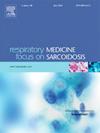探索COPD治疗的新方法:贝纳利珠单抗在体外3d模型中的作用
IF 3.5
3区 医学
Q2 CARDIAC & CARDIOVASCULAR SYSTEMS
引用次数: 0
摘要
最近的证据支持嗜酸性粒细胞炎症是COPD发病机制的一个相关组成部分的假设。本研究旨在评估Benralizumab对体外“COPD烟雾诱导”支气管黏膜等效物的影响。方法采用三维(3D)复合离体支气管黏膜,研究上皮-间充质营养单位(EMTU)修复、再生和分化的机制。在生长培养基和基膜提取物中培养一个月后,上皮细胞分化为纤毛细胞和产生粘液的细胞,间充质细胞分化为成纤维细胞。这种培养模型通过暴露于香烟烟雾提取物诱导表达炎症表型。嗜酸性粒细胞(Eos)被放置在结缔层下面,而单核细胞被激活并收集单核细胞条件培养基(MCM)。炎症细胞通过细胞因子的产生与常驻细胞建立了串扰。该方案包括四种实验条件:未经处理的对照(K)、Eos单独(EO)、Eos + MCM (EOMO)、Eos + MCM + Benralizumab (EMB)。结果分析了基底侧和根尖侧细胞因子的浓度。在基底侧,IL(白细胞介素)-5在加入嗜酸性粒细胞和单核细胞后显著升高,在引入贝纳利珠单抗后下降(治疗14天后,K组:14.6±3.2 pg/mL;EO组:13.9±4.2 pg/mL;EOMO组:35.7±5.9 pg/mL;EMB组:14.04±4 pg/mL;0.005)。这种减少持续了14天。EOMO组IL-6和IL-15浓度较高,EMB组IL-6和IL-15浓度均降低。结论:本研究结果有助于推测benralizumab对其他炎症靶点的潜在作用。本文章由计算机程序翻译,如有差异,请以英文原文为准。
Exploring a novel approach to COPD treatment: benralizumab effect in an ex vivo 3-D model
Background
Recent evidence supports the hypothesis that eosinophilic inflammation is a relevant component in the pathogenesis of COPD.
Objective
The current study aimed to assess the effects of Benralizumab, on ex vivo “COPD smoke-induced” bronchial mucosa equivalents.
Methods
Three-dimensional (3D) composite ex-vivo bronchial mucosa are used to study the mechanisms of repair, regeneration and differentiation within the epithelial-mesenchymal trophic unit (EMTU). After a one month incubation in growth medium and basal membrane extracts, epithelial cells differentiate into ciliated and mucous-producing cells, and mesenchymal cells into fibroblasts. This culture model is induced to express an inflammatory phenotype through exposure to cigarette smoke extracts. Eosinophils (Eos) are placed underneath the connective layers, whereas monocytes are activated and monocyte conditioned medium (MCM) is collected. The inflammatory cells established a cross-talk with resident cells by cytokine productions. The protocol included four experimental conditions: untreated control (K), Eos only (EO), Eos + MCM (EOMO), Eos + MCM + Benralizumab (EMB).
Results
Cytokine concentrations at basal and apical side were analyzed. At basal side, IL (interleukin)-5 significantly increased after the addition of eosinophils and monocytes, and decreased after the introduction of Benralizumab to the culture (after 14 days of treatment, K group: 14.6 ± 3.2 pg/mL; EO group: 13.9 ± 4.2 pg/mL; EOMO group: 35.7 ± 5.9 pg/mL; EMB group: 14.04 ± 4 pg/mL, p < 0.005). The reduction persisted for the subsequent 14 days. IL-6 and IL-15 concentration was high in EOMO groups while EMB groups had a reduction in both interleukins concentration.
Conclusion
The findings described lead to speculate on a potential action of benralizumab on alternative inflammatory targets.
求助全文
通过发布文献求助,成功后即可免费获取论文全文。
去求助
来源期刊

Respiratory medicine
医学-呼吸系统
CiteScore
7.50
自引率
0.00%
发文量
199
审稿时长
38 days
期刊介绍:
Respiratory Medicine is an internationally-renowned journal devoted to the rapid publication of clinically-relevant respiratory medicine research. It combines cutting-edge original research with state-of-the-art reviews dealing with all aspects of respiratory diseases and therapeutic interventions. Topics include adult and paediatric medicine, epidemiology, immunology and cell biology, physiology, occupational disorders, and the role of allergens and pollutants.
Respiratory Medicine is increasingly the journal of choice for publication of phased trial work, commenting on effectiveness, dosage and methods of action.
 求助内容:
求助内容: 应助结果提醒方式:
应助结果提醒方式:


